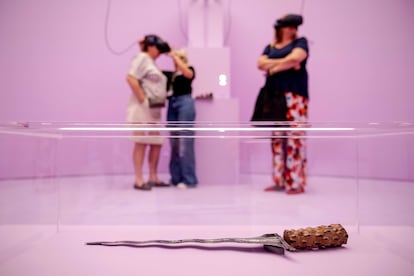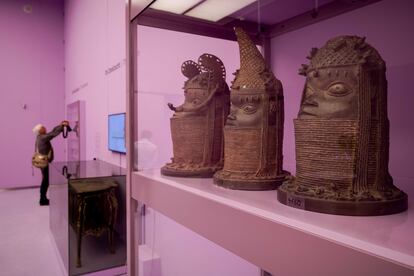Virtual reality and replicas enter the debate on the return of looted art
The Mauritshuis gallery in the Netherlands and the Humboldt Forum in Berlin have joined forces in an exhibition that addresses the looting of art that has sustained European collections for centuries


Bare, pink-lined walls welcome visitors to the temporary exhibition hall of the Dutch Mauritshuis gallery, home to what is arguably Vermeer’s most famous painting, Girl with a Pearl Earring. Virtual reality (VR) glasses are available for visitors to use at various stations around the space, while in the next room are replicas of the Benin Bronzes that were looted from Nigeria by European colonizers. In front of them, on a kind of pedestal, the sculpted head of a horse stands out. It is the only thing that remains of the original chariot on the Brandenburg Gate in Berlin, destroyed in World War II. In the background hang two paintings. They are part of the loot stolen by French revolutionary troops during the invasion of the Netherlands in the 18th century. The exhibition, entitled Roofkunst - 10 verhalen [Loot – 10 stories], has been presented in collaboration with the Berlin Humboldt Forum, and blends art and technology to stimulate a debate on the restitution of stolen pieces. It focuses on 10 stories from three periods: the colonial era, the French Revolution and the Nazi looting. Along the way, the visitor is invited to imagine the museum of the future with the help of digital media.
Once museum goers have gotten over the unusual aesthetic of the exhibition space, the first virtual experience begins. Wearing the VR glasses and keeping one hand on a real railing, visitors have a breathtaking view. They are standing next to the chariot on top of the Brandenburg Gate, the famous 18th century neoclassical monument that is on the must-see list of every visitor to Berlin. Hence the railing, in case they are overcome by vertigo. Below, Napoleon’s troops enter on horseback in a triumphal procession on a gray October morning. The chariot was taken to France in 1806 as a war trophy and returned to Berlin after Napoleon’s defeat less than a decade later. When the Nazis came to power, the gate went from being a Prussian triumphal arch to a symbol of Hitler’s dictatorship. Only the horse’s head survived the Allied bombings in World War II, and it was kept in the Stadtmuseum in Berlin. The chariot atop the monument today is a reproduction of the original and was installed in 1958. Taking off the VR glasses, the enormous, green horse’s head, green and enormous, seems more real than ever.
“We had to go from what remains of the original to the replica to create the virtual experience, which transports the public to historical moments like this,” explains Kel O’Neill, guest curator. He has directed the creative aspect of the exhibition together with his partner, Eline Jongsma, and adds: ”We wanted to take the visitor out of the museum environment to see the objects in their historical context and think about where the artifacts now on display in the museum might be in the future.” “We live in an increasingly digital space, and we were interested in the idea of a museum where art that has been returned to its owners exists in an equally digital form,” says Jongsma. “We are not saying that in the future art galleries should combine real pieces and copies or replicas. We wonder about the value of an original, which will not lose its luster even if there are other ways of representing it,” she continues.

In an exhibition dedicated to stolen art, context is essential, but so is international collaboration. “It is necessary inside and outside Europe because the objects have passed through many places,” says Martine Gosselink, director of the Mauritshuis. As an example, she talks about a cane from Suriname, which is on display for the first time, and is in the Ethnologische [Ethnological] Museum’s collection in Berlin. It belonged to the Maroon community, descended from African slaves who escaped from plantations during the Dutch colonial period. “It is loot, and it is a cross-border story,” says the director. Jongsma and O’Neill have made a documentary that shows the effect of this type of robbery on the collective memory of its owners. “How will the descendants know that the cane is in Berlin? Visibility plays a role,” says Jongsma.
Most looted art ended up in European museums in the 19th and 20th centuries, and the answer to how and to whom to return has not always been simple. In some cases, however, the entire route of the artwork can be traced. It happened with a self-portrait by Rembrandt, dated 1669. Protected by glass, it is resting on the exhibition’s floor. It is not for lack of respect for the Dutch Master. It is just that this story also includes virtual reality support, and visitors have to sit down for it. In 1940, the canvas was owned by the German Jewish Rathenau family. They had to flee to the Netherlands and then to the United Kingdom and the United States, and they could not recover the painting. Stolen by the Nazis for a future Führer Museum that was never created, the Nazis set out to destroy all their stolen art. With the 3D glasses on, the scene takes place inside a salt mine in Altaussee, Austria. Filled with paintings and valuable objects, Rembrandt’s painting is near a half-open door. Outside, “the brave miners who managed to remove the bombs” planted by the Nazis and save the art treasures are speaking. The allied group of art experts called the Monuments Men recovered much of what was looted, and this painting was returned to the Rathenaus. In 1947, they sold it to the Mauritshuis.

In the case of the Benin Bronzes, the Dutch gallery presents replicas and their molds. “They are among my favorites because when they arrived in the collection, in Germany, we made molds and produced copies soon afterward. With their return to Nigeria in 2022, the reproductions open yet another debate about value in the context of the market. For example, if the rights to reproduce the works are also returned,” says O’Neill. It seems to him that the original bronze will not lose its value even if there are other ways of representing it. How many Dutch people know that there are almost a hundred paintings in Paris, stolen by the French in the 18th century? It is a question that the director of the Mauritshuis has asked herself in public, and there are two works here that illustrate it. This is a canvas by the Dutch painter Paulus Potter, Cows Reflected in Water (1648), and another by Jan Mijtens, The Marriage of Friedrich Wilhem, Elector of Brandenburg and Louise Henriette of Orange (1646). They were taken by the French in 1794 when they invaded the Netherlands. Much of the collection of William V, who fled to England, was declared the property of France and around 200 works ended up in the Louvre Museum. After Napoleon’s defeat at Waterloo in 1815, it was not possible to recover about 70 pieces of art. Mijtens’ painting remained in France and has been loaned especially for the exhibition.
Why has it not been reclaimed? The response of the Mauritshuis is clear: because it was plundered, but it is no longer perceived as an injustice. Instead, they serve as ambassadors of Dutch art; because the Netherlands has enough masterpieces in its collections; and because there is no humiliation, exploitation, or racism involved. “Robbing from a vulnerable community is not the same as doing it as a state, and the idea of the exhibition is not to compare it. With this exhibition, the gallery has taken a risk by offering something new, and we think it is good that from a privileged position in a privileged country, it [the gallery] participates in an ongoing debate,” Jongsma and O’Neill say in unison. In addition to the Humboldt Forum, the Stadtmuseum, Ethnologisches Museum, and the Museum für Asiatische Kunst (the Museum of Asian Art), all in Berlin, have participated in the exhibition. The exhibition opens in Berlin in 2024.
Sign up for our weekly newsletter to get more English-language news coverage from EL PAÍS USA Edition
Tu suscripción se está usando en otro dispositivo
¿Quieres añadir otro usuario a tu suscripción?
Si continúas leyendo en este dispositivo, no se podrá leer en el otro.
FlechaTu suscripción se está usando en otro dispositivo y solo puedes acceder a EL PAÍS desde un dispositivo a la vez.
Si quieres compartir tu cuenta, cambia tu suscripción a la modalidad Premium, así podrás añadir otro usuario. Cada uno accederá con su propia cuenta de email, lo que os permitirá personalizar vuestra experiencia en EL PAÍS.
¿Tienes una suscripción de empresa? Accede aquí para contratar más cuentas.
En el caso de no saber quién está usando tu cuenta, te recomendamos cambiar tu contraseña aquí.
Si decides continuar compartiendo tu cuenta, este mensaje se mostrará en tu dispositivo y en el de la otra persona que está usando tu cuenta de forma indefinida, afectando a tu experiencia de lectura. Puedes consultar aquí los términos y condiciones de la suscripción digital.
More information
Archived In
Últimas noticias
Most viewed
- Reinhard Genzel, Nobel laureate in physics: ‘One-minute videos will never give you the truth’
- Oona Chaplin: ‘I told James Cameron that I was living in a treehouse and starting a permaculture project with a friend’
- Pablo Escobar’s hippos: A serious environmental problem, 40 years on
- Why we lost the habit of sleeping in two segments and how that changed our sense of time
- Chevy Chase, the beloved comedian who was a monster off camera: ‘Not everyone hated him, just the people who’ve worked with him’










































